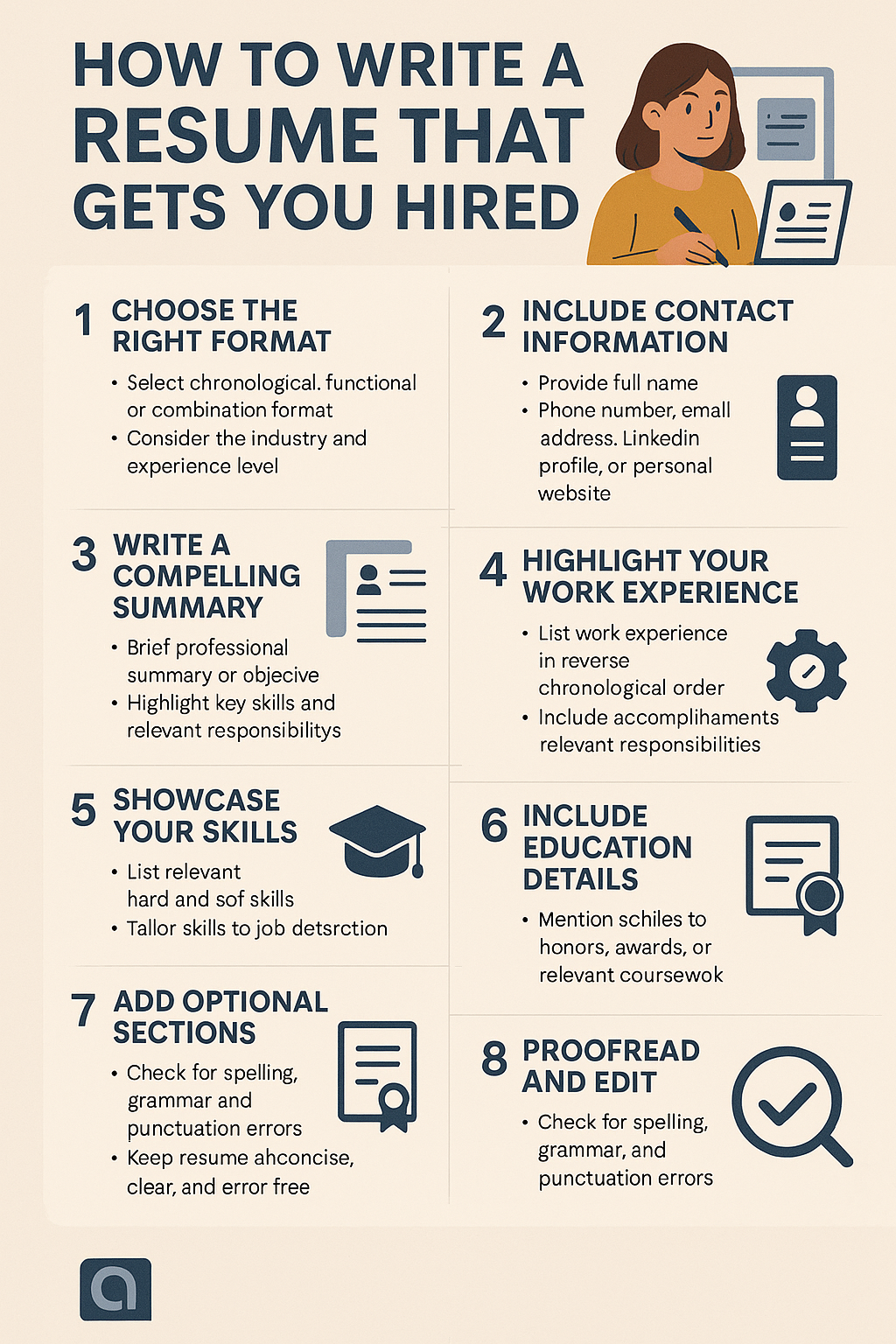How to Write a Resume That Gets You Hired
In this guide, we’ll walk you through the step-by-step process of creating a compelling resume that gets results.

In a world where recruiters spend mere seconds scanning resumes, knowing how to write a resume that stands out is essential. Your resume is your first impression and a critical tool in your job search. A well-crafted resume not only showcases your qualifications but also positions you as the ideal candidate for the job. In this guide, we’ll walk you through the step-by-step process of creating a compelling resume that gets results.
1. Understand the Purpose of a Resume
Before diving into the structure and content, it’s important to understand what a resume is meant to achieve. A resume is not just a summary of your job history; it’s a strategic marketing document that highlights your skills, experience, and achievements in a way that aligns with the job you’re applying for. Your goal is to convince the hiring manager that you’re worth interviewing.
2. Choose the Right Resume Format
The format you choose plays a key role in how your information is presented:
- Chronological Resume: Lists your work history in reverse chronological order. Best for professionals with consistent work experience.
- Functional Resume: Focuses on skills rather than work history. Ideal for career changers or those with gaps in employment.
- Combination Resume: Blends both skills and work history. Good for highlighting transferable skills and relevant experience.
Pick the format that best suits your career path and the job you’re targeting.
3. Start with a Strong Header
Your resume should begin with your full name, contact information, and a link to your LinkedIn profile or professional portfolio (if applicable). Ensure your email address is professional and your phone number is active.
Example: Jane Smith
janesmith@email.com | (123) 456-7890
linkedin.com/in/janesmith
4. Write a Compelling Summary Statement
A summary statement is a brief section at the top of your resume that outlines who you are and what you bring to the table. It should be tailored to the role and highlight your most relevant strengths.
Example: “Results-driven digital marketing specialist with over 5 years of experience in SEO, content creation, and paid advertising. Proven ability to increase web traffic by over 60% through strategic campaigns. Seeking to bring my skills to a dynamic marketing team.”
5. Highlight Your Key Skills
Include a section that lists hard and soft skills relevant to the job. Use bullet points for clarity, and try to match the keywords found in the job description.
Example Skills:
- Project Management
- Data Analysis
- Microsoft Excel & Power BI
- Team Leadership
- Customer Relationship Management (CRM)
6. Showcase Your Work Experience
This section should clearly demonstrate your accomplishments, not just your duties. Use the STAR method (Situation, Task, Action, Result) to quantify your impact whenever possible.
Example: Marketing Coordinator
XYZ Corp, New York, NY | Jan 2021 – Present
- Managed content strategy across 3 channels, increasing user engagement by 40%.
- Collaborated with cross-functional teams to launch 5 new product campaigns.
- Optimized email marketing resulting in a 25% increase in open rates.
List your experience in reverse chronological order, starting with your most recent job.
7. Include Education and Certifications
Mention your highest level of education and any certifications relevant to the role. Include the institution name, degree or certification, and graduation date.
Example: Bachelor of Arts in Communications
University of California, Los Angeles (UCLA) – 2018
Certified Digital Marketing Professional (CDMP) – Digital Marketing Institute, 2022
8. Add Optional Sections Wisely
Depending on your background and the job, consider adding these optional sections:
- Volunteer Work: Great for showcasing soft skills and community involvement.
- Awards and Honors: Demonstrates recognition and credibility.
- Languages: Useful for roles in global companies.
- Professional Associations: Shows commitment to your industry.
9. Tailor Your Resume for Each Job Application
A common mistake job seekers make is sending the same resume to multiple employers. Customize your resume for each application by:
- Incorporating job-specific keywords.
- Highlighting the most relevant skills and experiences.
- Aligning your summary statement with the job description.
This personalized approach increases your chances of getting noticed by both recruiters and Applicant Tracking Systems (ATS).
10. Focus on Clean, Professional Design
Presentation matters. Use a clean, easy-to-read font like Arial or Calibri. Stick to a professional layout with consistent formatting and plenty of white space. Avoid using multiple colors or graphics unless you’re applying for a creative role.
Keep your resume to one page if you have under 10 years of experience. For more experienced professionals, two pages are acceptable.
11. Proofread Thoroughly
Nothing turns off recruiters faster than spelling or grammar mistakes. Use tools like Grammarly or Hemingway Editor to catch errors. Better yet, have a trusted friend or mentor review your resume before submitting it.
12. Use Action Verbs and Quantifiable Results
Begin each bullet point in your work experience section with strong action verbs like “developed,” “led,” “optimized,” or “achieved.” Pair these with quantifiable outcomes to demonstrate impact.
Example: “Increased customer retention by 15% through targeted loyalty programs.”
How to Write a Resume – Infograph

Conclusion
Knowing how to write a resume that effectively markets your skills and achievements can dramatically improve your chances of landing a job interview. By following these proven strategies—from choosing the right format and writing a compelling summary, to tailoring your resume for each job and focusing on results—you’ll be well on your way to securing your dream role.
Keep refining your resume as you gain new experience and insights, and remember that your resume is a living document. For more tips on job hunting and career success, explore our expert resources at naukriytes.com.


